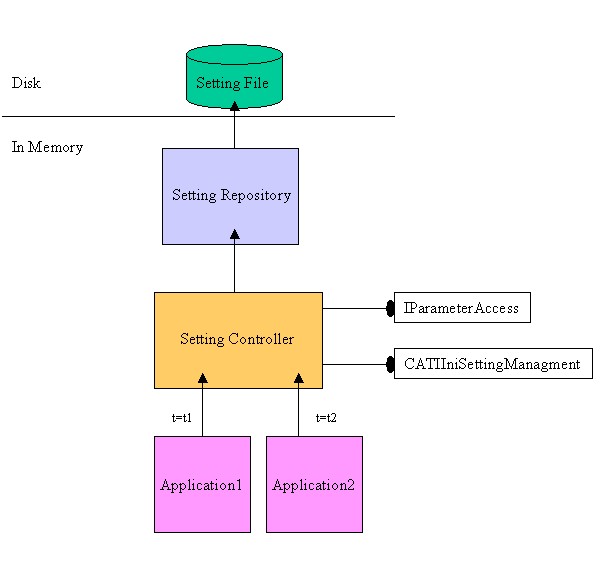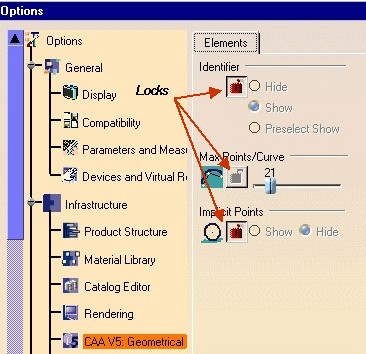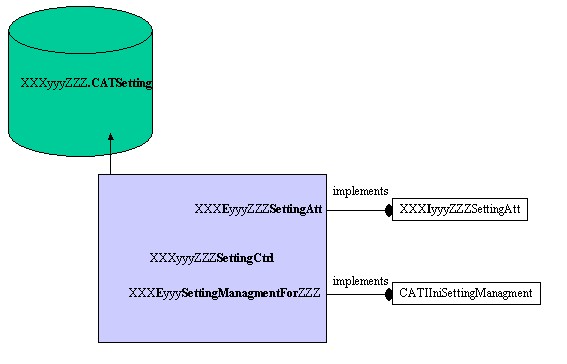
3D PLM Enterprise Architecture |
User Interface - Frame |
The Setting ControllerEncapsulating the access to the setting file |
| Technical Article | ||
AbstractThis article illustrates what a setting controller is, and explains how to create one. |
The setting controller enables several applications to access the parameters stored in a setting file, without having to know about the internal storage details. Setting controllers ensure a consistent access to settings information for applications, the Tools/Options command being the most important of these applications.
 |
As you can see from the above figure, the setting controller is the interface between one application and the setting repository [1], the latter being the memory representation of the setting file. The controller is a component that implements two interfaces:
This interface, defined in the InteractiveInterfaces framework, manages the
general methods of the setting repository: Commit, Save, Rollback and
ResetToAdminValues.
This interface, whose signature depends on the setting file, enables the access to the parameters.
![]() Applications using a setting controller are commands. If your command modifies
parameters it must be exclusive (
Applications using a setting controller are commands. If your command modifies
parameters it must be exclusive (CATCommandModeExclusive)
like any command which modifies data model.
[Top]
The setting repository contains setting attributes accessible thanks to the ReadSetting
and WriteSetting methods. Using these methods ties the code to the
formats and locations of the attributes. To enable attribute format and location
modifications while ensuring client code compatibility, it is advised to
encapsulate the attribute access using an interface which increases the
semantic in having parameter access.
For each parameter, you need to provide:
This method calls one or several ReadSetting methods. This
depends on the number of setting attributes that the xxx the parameter
represents
This method calls one or several WriteSetting methods. This
depends on the number of setting attributes that the xxx the parameter
represents
To ensure a good use of the setting repository, it is necessary to load or to
create in memory all the setting attributes of the setting file. This operation
must be done just before the first use of the setting controller, in other words
just after its creation. It is the role of the Initialize
method. Refer to the section "The Life Cycle of the
Setting Object", for the use of this method.
The Initialize method consists in calling all Getxxx
methods, which contain the call to the appropriate ReadSetting
method of the CATSettingRepository class.
![]() When
you enrich your setting file with new parameters, you have to modify the
When
you enrich your setting file with new parameters, you have to modify the Initialize
method, so that it calls the new Getxxx methods.
In a Property Page of the Tools/Options command, the administrator has the possibility to "lock" parameters [1].
 |
In the above figure, the administrator has locked the "Identifier" parameter to the "Show" option and the "Implicit Points" parameter to the "Hide" option. The end user is still free to modify the value of the maximum points used to discretize a curve, but cannot modify the two other parameters.
The dialog object acting as a lock is an instance of the CATDlgLock
class whose constructor takes one or a list of CATSettingInfo instances
in input. Each instance of CATSettingInfo, retrieved thanks to the GetInfo
method of the CATSettingRepository class, represents an attribute for a
setting repository. If the lock controls only one attribute, the CATDlgLock
constructor needs one instance of CATSettingInfo. Moreover, if the lock
controls several attributes the constructor needs several instances of CATSettingInfo.
Refer to the use case "Creating a Property Page for Application
Properties" [2] for an example on how to use CATDlgLock
and CATSettingInfo classes.
For each xxx parameter, you need to provide:
HRESULT GetInfoxxx(CATSettingInfo ** oInfoArray, int
iNbSettingInfo) = 0;This method calls one or several GetInfo methods. This depends
on the number of setting attributes that represent the parameter.
Remark: If the parameter is represented by one attribute, and if you are
sure this will not change over time, you can simplify the signature of the
method: GetInfoxxx(CATSettingInfo * oInfo)
[Top]
This section describes the classes and the interface needed to create a Setting Controller in order to take into account a naming rule. Refer to the use case "Creating a Setting Controller" [3] for a concrete example.
The setting file is named XXXyyyZZZ.CATSetting, where:
 |
As you can see in the above figure, the controller is a component named XXXyyyZZZSettingCtrl which implements:
Here are the classes and interfaces needed to be created in your framework:
[Top]
In most cases, to access and modify a parameter, the setting controller reads and writes data from and to the setting repository. But to enhance performances, the setting controller can save values without making an automatic synchronization with the setting repository. To ensure the validity of the data, the setting controller must be unique during the session. This methodology must be used, even if your setting controller modifies directly the setting repository since it allows a possible evolution of your code.
The main component class of the setting controller, named XXXyyyZZZSettingCtrl in the previous section, contains:
GetSettingControllerThis method creates a XXXyyyZZZSettingCtrl class only if it does not already exist, otherwise the pointer comes from the next static data.
In this method, immediately after the first and unique class creation, you must initialize the setting repository by calling:
- the
Initializemethod of the XXXIyyyZZZSettingAtt interface- the
Commitmethod of the CATIIniSettingManagement interface, to save the values that would be used in case a rollback is invoked.
This data member is not a XXXyyyZZZSettingCtrl pointer, it is a CATIniCleanerSettingCtrl instance. This class, defined in the InteractiveInterfaces framework, contains the XXXyyyZZZSettingCtrl pointer. This encapsulation is the means to delete the unique setting controller pointer at the end of the session. A static instance is already deleted, a pointer is not. So the destructor of the CATIniCleanerSettingCtrl releases the XXXyyyZZZSettingCtrl pointer.
[Top]
For completeness when creating an instance of any component, you should implement and use the CATICreateInstance interface (System framework). But since your component is unique during the session, you must create a global factory function which is a special factory. This public function enables the retrieval of an interface pointer on the setting controller. This global function is called GetXXXyyyZZZSettingCtrl.
[Top]
A setting controller enables the encapsulation for the access to the setting attributes, and ensures a consistent access through its uniqueness.
A setting controller is a component which implements:
Initialize methodGetxxx and Setxxx pair
of methods, and one GetInfoxxx methodCommit, Save, ResetToAdminValues and
Rollback.A setting controller is accessible through a global function which returns an interface pointer to the component.
[Top]
| [1] | Setting Repositories and Attributes |
| [2] | Creating a Property Page for Application Properties |
| [3] | Creating a Setting Controller |
| [Top] | |
| Version: 1 [Jan 2002] | Document created |
| [Top] | |
Copyright © 2002, Dassault Systèmes. All rights reserved.